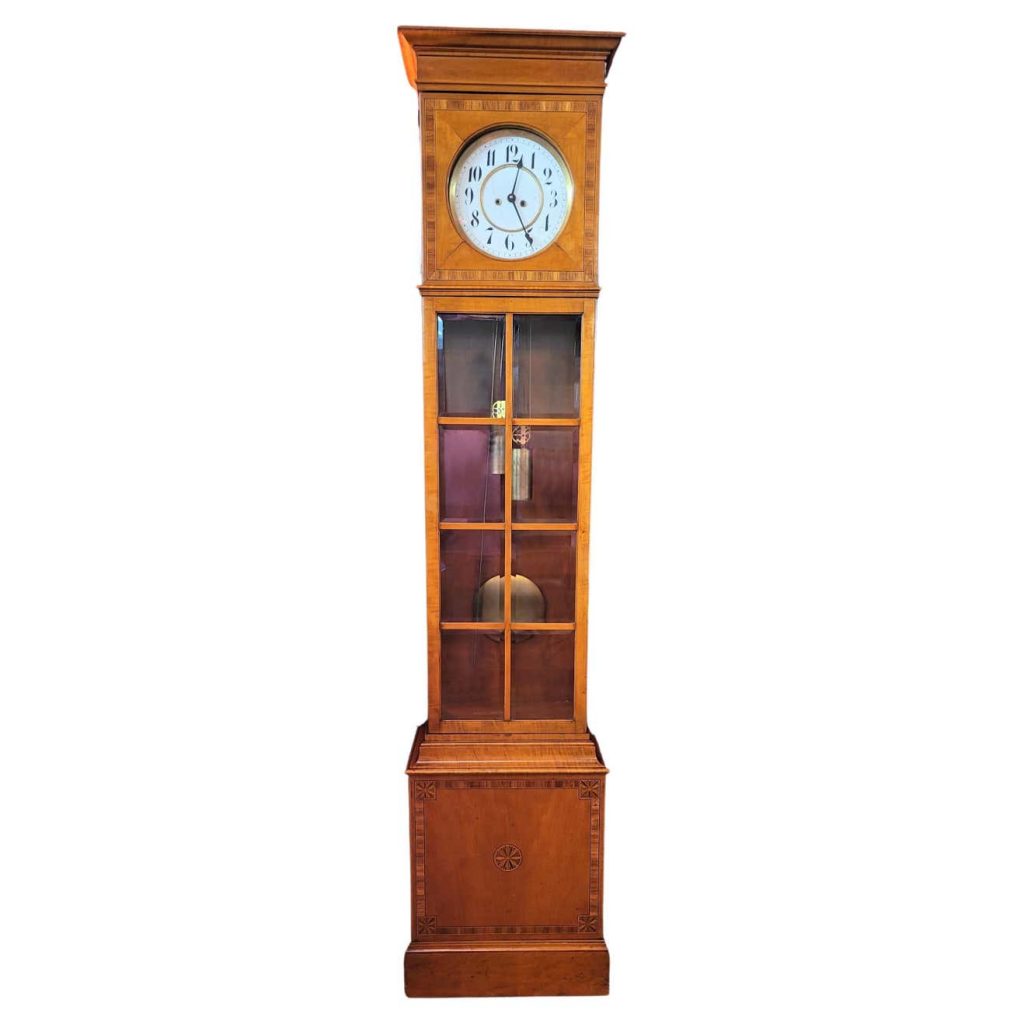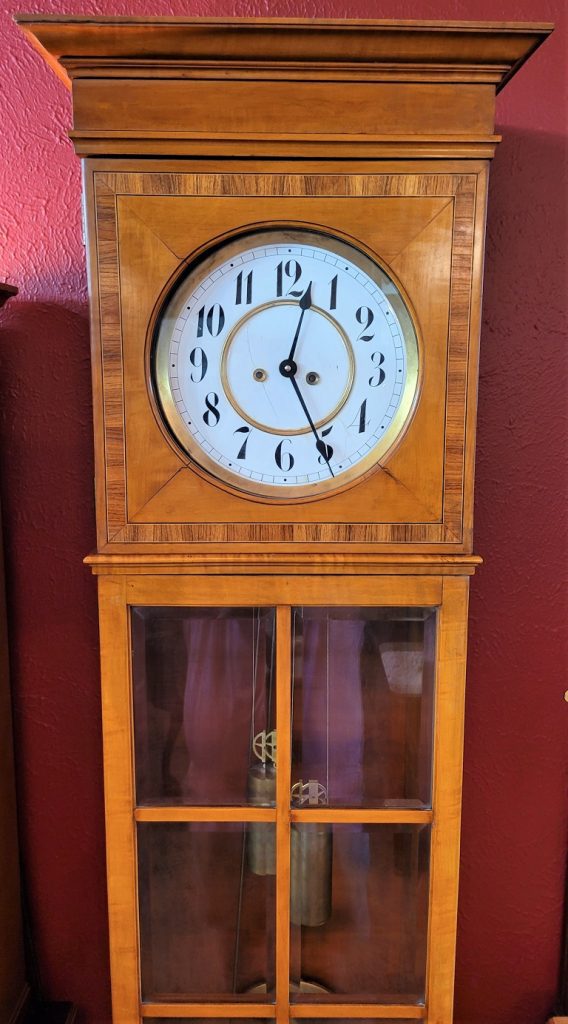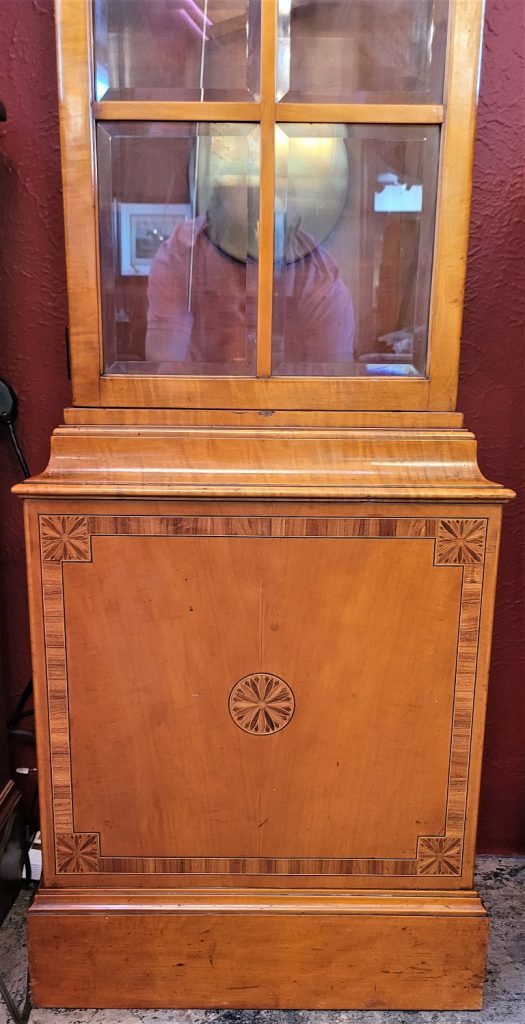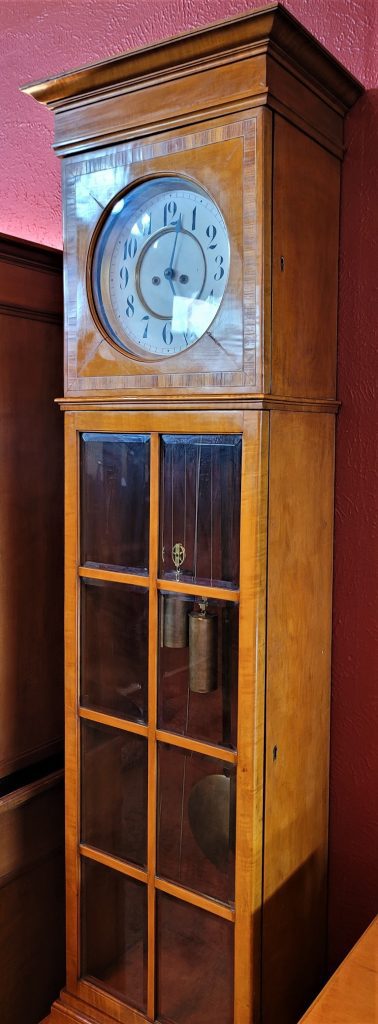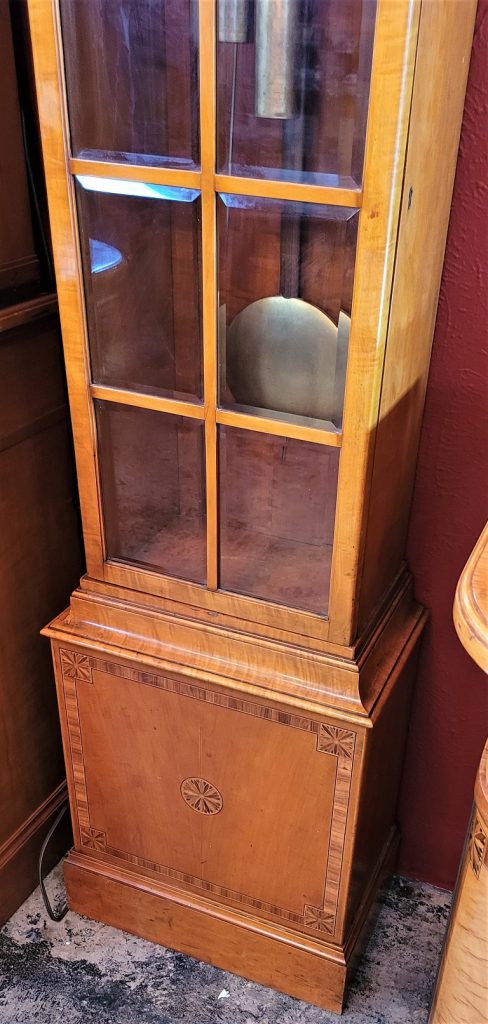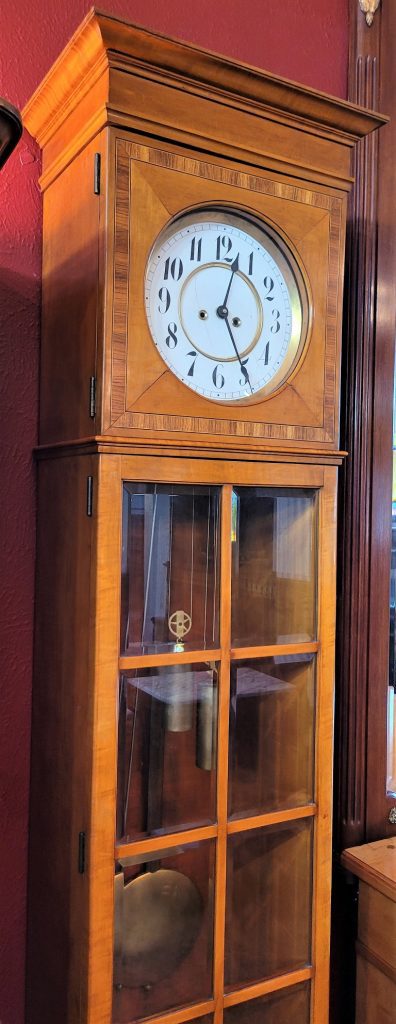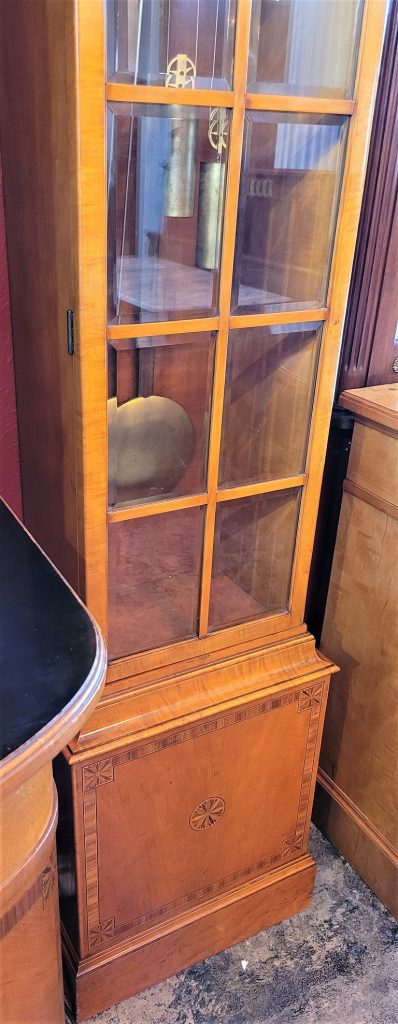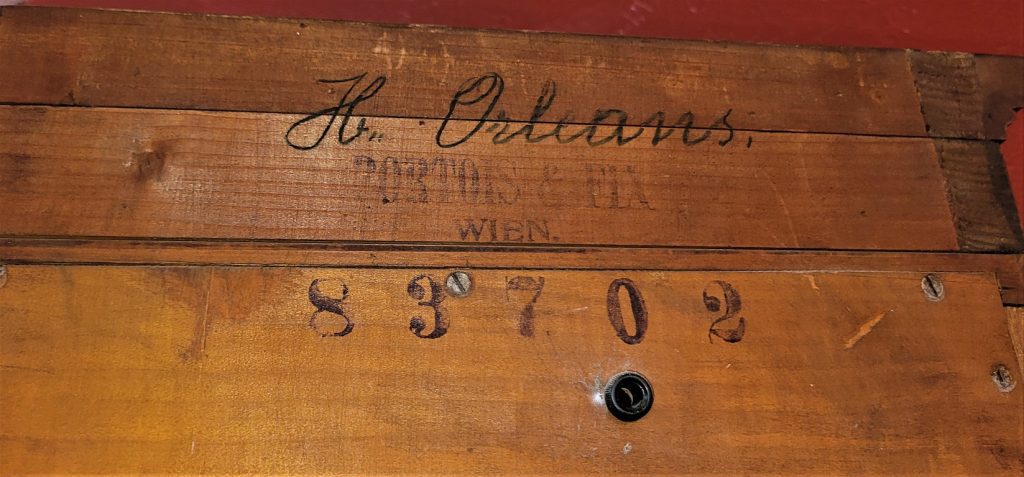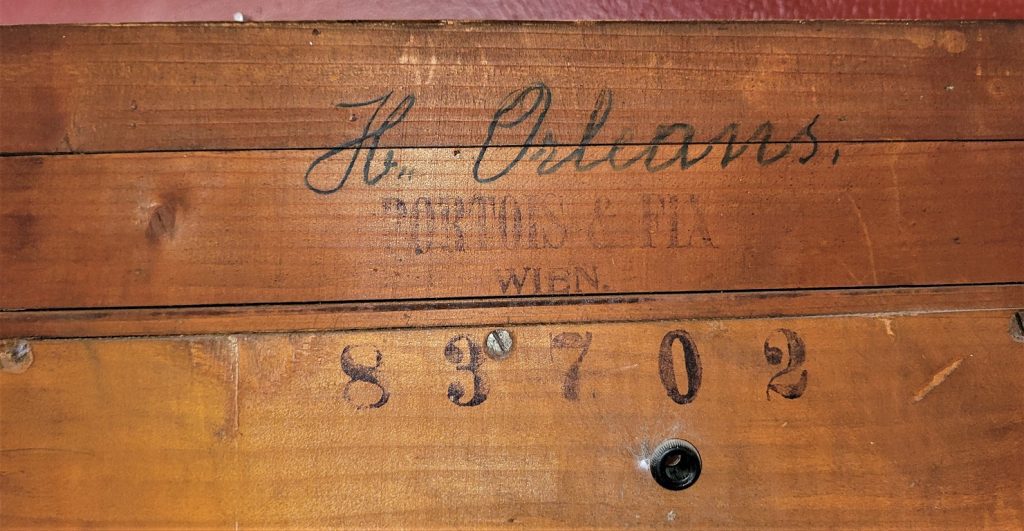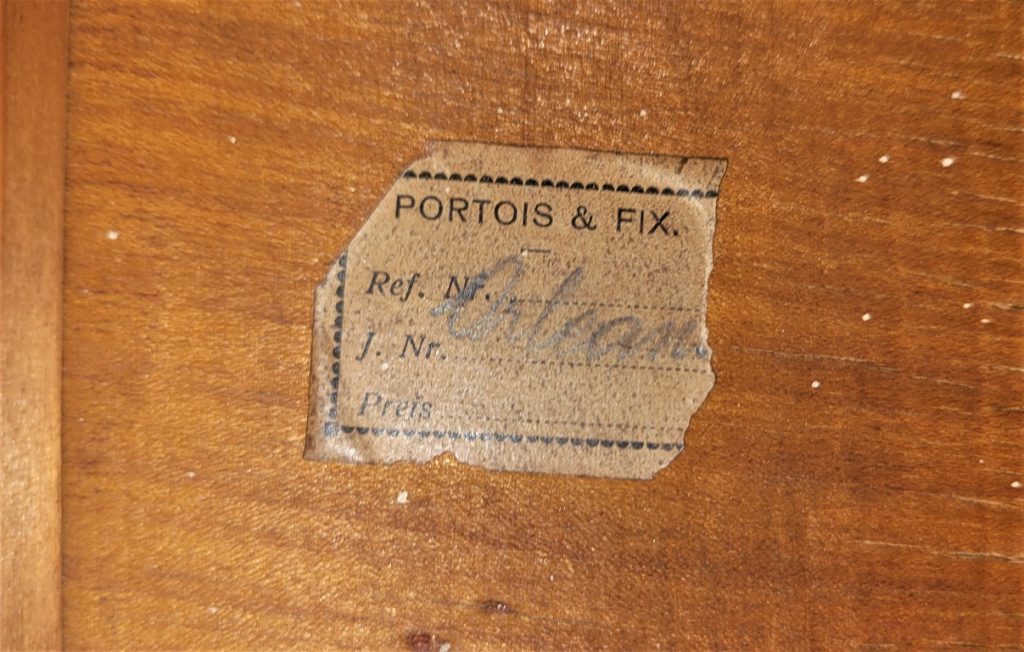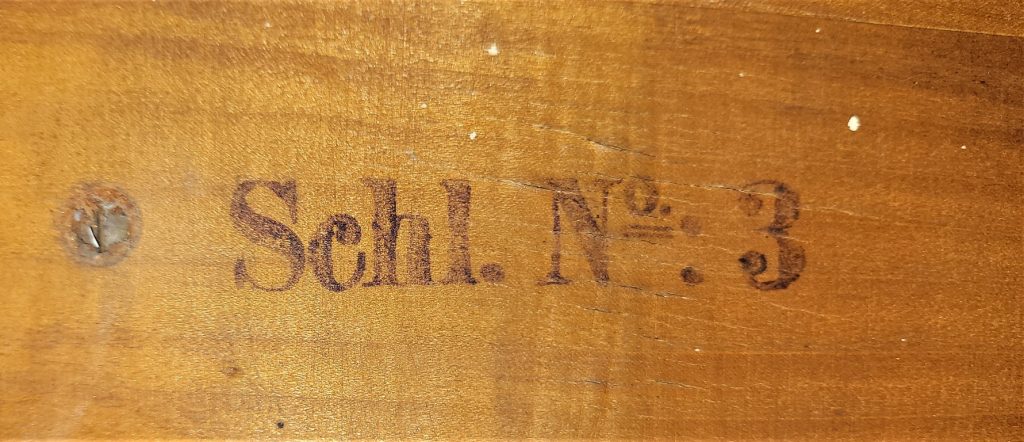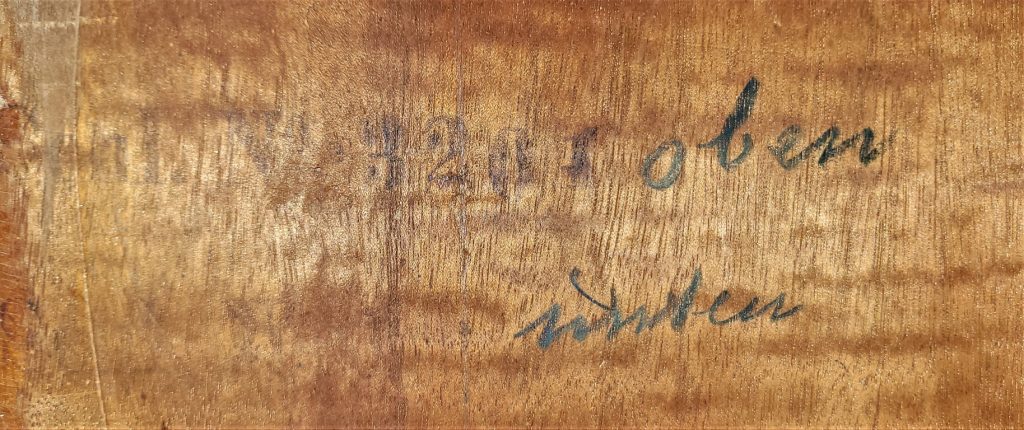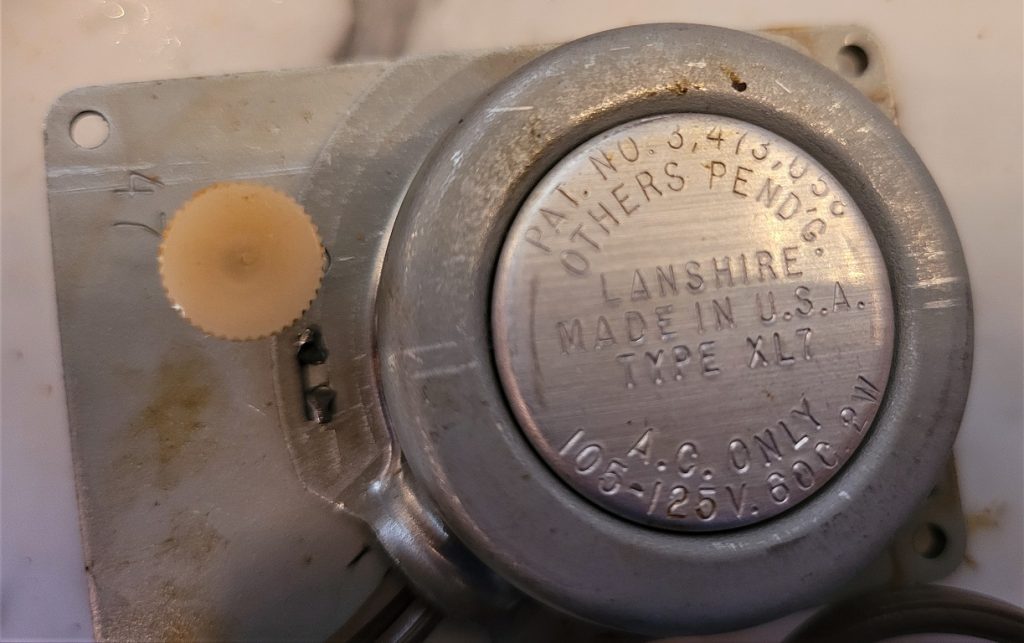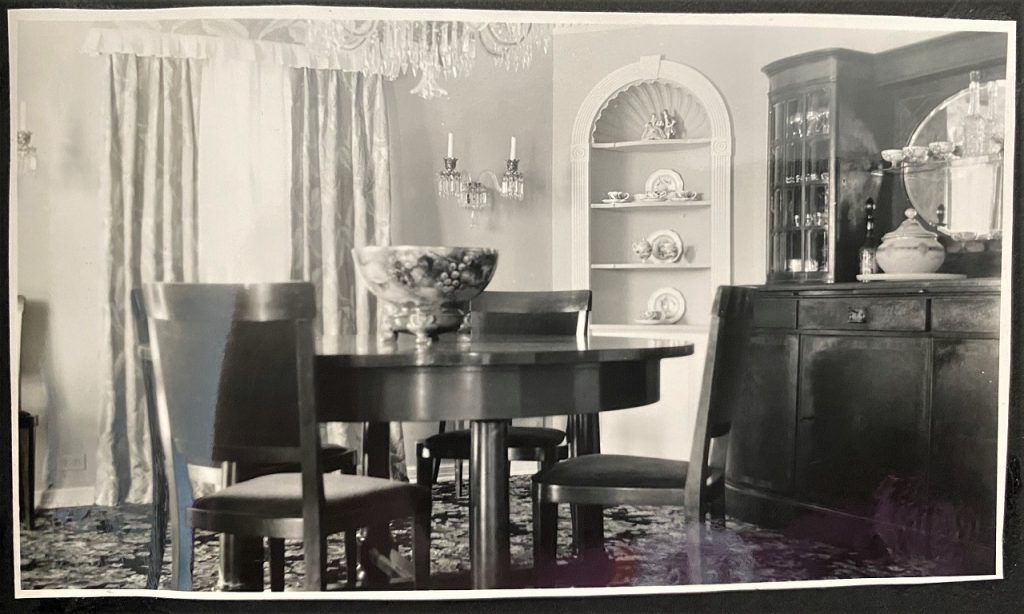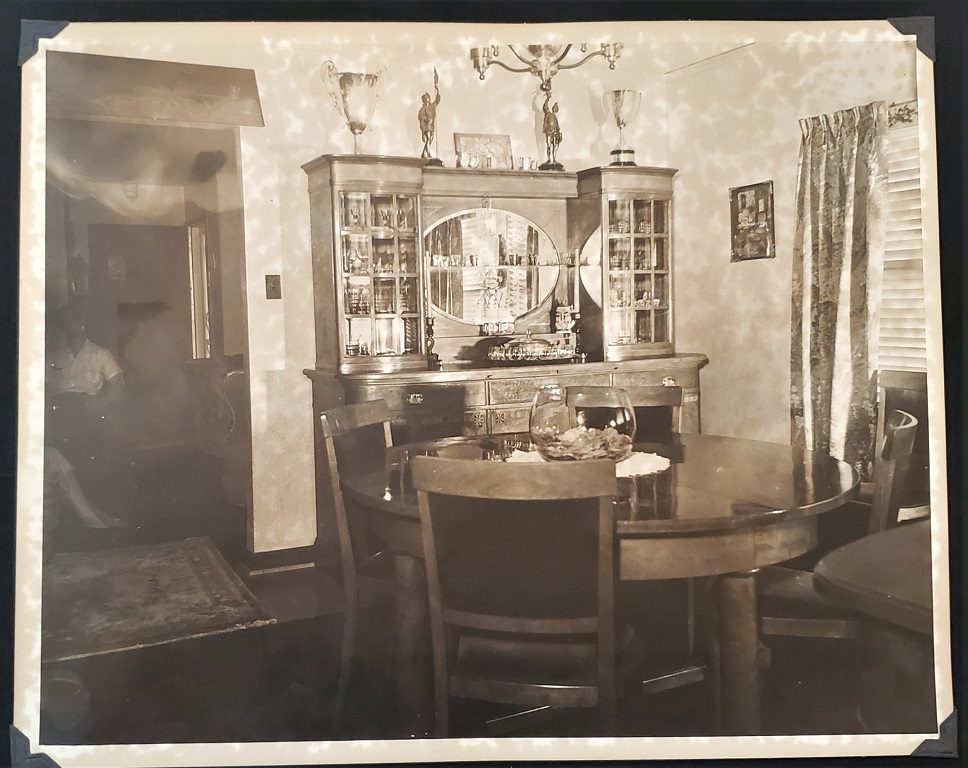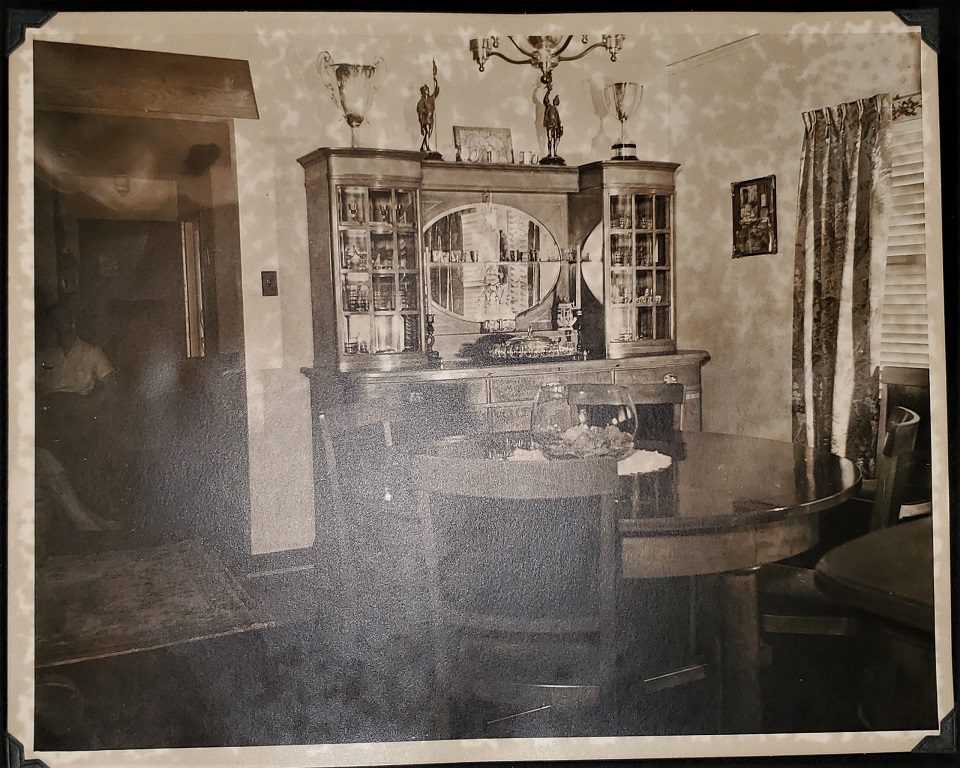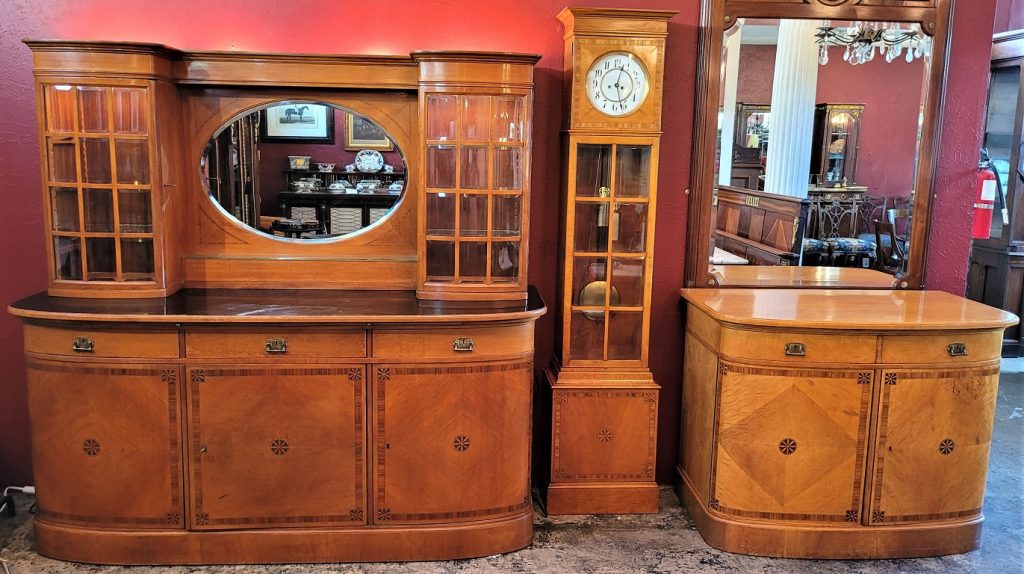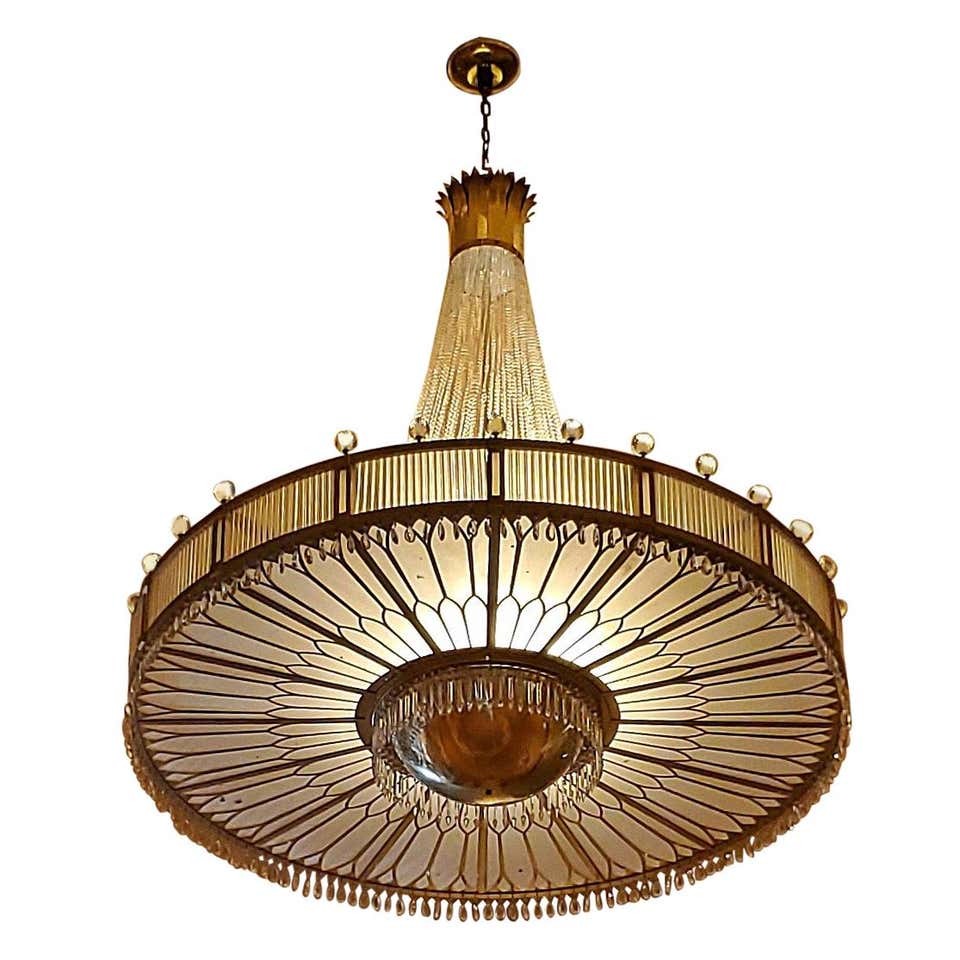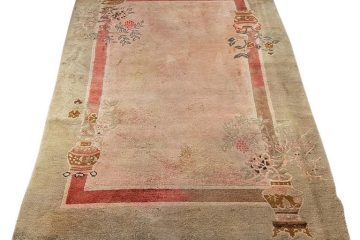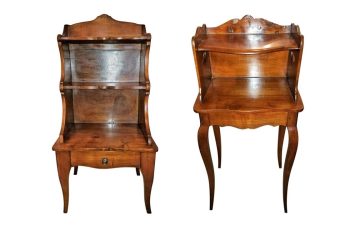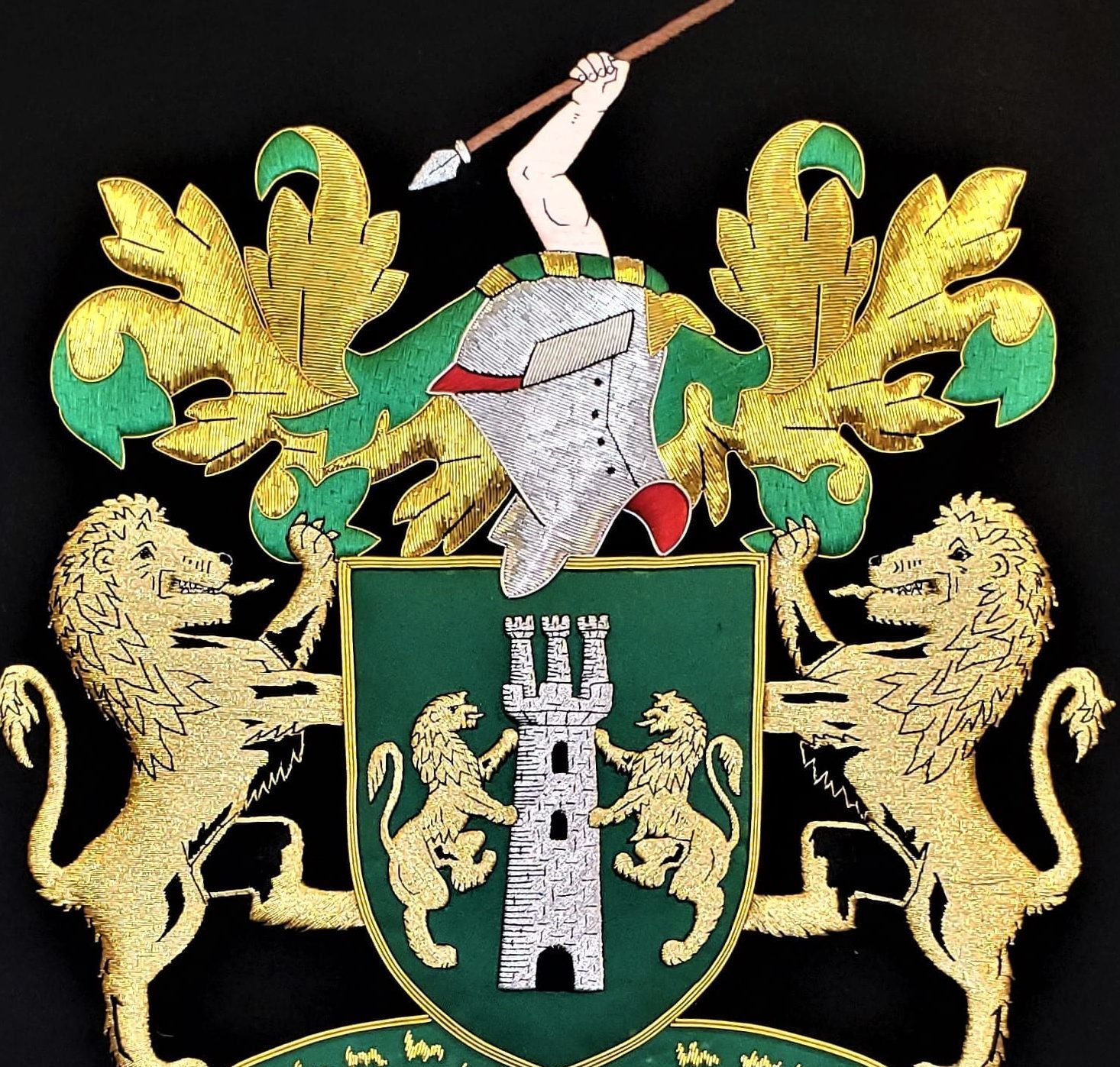PRESENTING AN AMAZINGLY RARE PIECE of Art Deco furniture by an EXCEPTIONALLY RARE MAKER, namely, an Art Deco Portois and Fix Viennese Tall Case Clock.
Part of a complete Dining Room Set comprising of 3 pieces – this Clock, Buffet/Sideboard and Credenza. All in our Inventory but being sold separately (or together if you have a desire to own the complete set which you will NEVER be in a position to do again).
Made in Vienna, Austria circa 1920-30 by the famous furniture maker of Portois & Fix.
The piece consists of a Tall Case Clock with glass display front.
The top section consists of a molded square pelmet with circular glass face door edged and banded with an inlaid border of parquetry inlaid woods. The door opens to the original porcelain clock/dial face with 2 original holes for winding. Hour and minute hands.
The original movement was removed in the 1950’s and replaced with an electric motor mechanism. This has now been replaced with a working battery operated quartz movement.
The pendulum and weights are the originals but are now only decorative in nature.
The main body of the clock is made up of a door with 8 beveled glass panels allowing views of the pendulum and weights.
The base section is likewise, edged and banded with an inlaid border of parquetry inlaid woods and a central parquetry medallion of inlaid woods.
Placed in connection with the other pieces in this Set, means we can say with certainty that this is an Art Nouveau moving into Art Deco piece, even though the design and style is more similar to Regency.
A STUNNING, IMPORTANT AND EXCEPTIONALLY RARE & DESIRABLE PIECE
Portois & Fix was a major furniture manufacturer and interior decorator in Austria-Hungary . The company in 1881 from Vienna was founded Tapezierermeister Anton Fix (1846-1918) and the French (other sources indicate Brussels) August Portois (1841-1895).
In 1842 Johann Fix founded a wallpapering workshop in Heumühlgasse 20 in the 4th district in Vienna . His son Anton took over in 1872 the operation. In the heyday of the company, Fix furnished flats of the Ringstraße buildings . At the World Fair in 1873 Fix received several awards.
In 1881, Anton Fix and furniture maker August Portois merged to form a single company and were thus able to provide complete home furnishings. In 1884 the furniture production was officially registered.
In 1883 the company was represented at the International Electrical Exhibition in Vienna. This was followed by orders from Germany, Russia, Turkey, Switzerland, Italy and Egypt. The two entrepreneurs opened branches in London, Milan, Paris, Wroclaw, Budapest, Cairo, Carlsbad, Bombay, Bucharest, Constantinople and Turin. In 1892, a “garde meuble” was built in Stadlau , where customers could have their furniture stored and repaired. Customers were the imperial court, imperial and royal highnesses, nobility, large industrialists, upper bourgeoisie as well as companies. At its peak, the company employed around 700 people. August Portois retired in 1892 from the company and returned to France, he died in 1895.
From 1897 to 1901, the architect Max Fabiani established the company headquarters at Ungargasse 59-61, in the 3rd district of Vienna ( Haus Portois & Fix ). This building had a spectacular façade for the time, with uniform, ornamented tiles. The young architect caused a scandal with the controversial architectural style.
From 1890 Portois & Fix worked closely with artists, especially later with the Wiener Werkstätte . With the execution of designs by Otto Wagner , Max Fabiani , Koloman Moser and Josef Hoffmann , Portois & Fix were among the greats of “Viennese Modernism” around 1900. At this time the company employs 700 people. Many works from this period were presented in craft exhibitions and published in craft magazines. The furniture of the Wiener Werkstätte can be seen in various museums today and can often be found in auction houses.
Anton’s son Robert Fix (1877-1945) had also profiled himself as a furniture designer in the company; until the death of his father in 1918 he worked in the company. After the demise of Anton Fix Robert had dedicated himself to painting, studied at the Academy of Fine Arts in Vienna and designed many things. With the end of the monarchy, however, the heyday of Portois & Fix slowly came to an end. After the First World War , the company still produced furniture.
The company Portois & Fix was run for years under the direction of other shareholders. From 1959 the company was registered as a sole proprietorship under Liselotte Simon (born August 2, 1919) and from 1974 under the direction of their daughter Brigitte Engelhardt. The address was at Barichgasse 30 in the 3rd district of Vienna. The company specialized in commissioned works such as the Burgtheater, State Opera House, Parliament, Spanish Riding School, branches of Creditanstalt and other banks, Augarten Porcelain, WIFI, ÖMV, ORF and the Royal Palace of Amman.
On June 16, 2004, the company was converted into a sole proprietorship, but today only repairs to existing facilities are carried out.
In the summer of 2008, the museum in the Austrian Post Savings Bank in cooperation with the Hofmobiliendepot showed an exhibition on Portois & Fix .
Link: https://de.wikipedia.org/wiki/Portois_%26_Fix
We have another exceptionally rare piece by Portois & Fix in our Inventory which in it’s style and design was clearly made by the company towards the end of the 19th Century when they were furniture makers to the Habsburg’s (The Austrian Royal Family). It is clearly in the style of Louis XVI pieces and totally different from this dining room set. Clearly, after the end of WW1 the Habsburg Empire came to an end and Portois & Fix started making much more utilitarian furniture for the high-end international buyer. This is how we can date this piece as it is clearly in the transition period between Art Nouveau and Art Deco of the late 1920’s and early 1930’s.
Also, this piece (and the entire dining room set) have specific and important PROVENANCE, which not only establish it’s authenticity but it’s individual history.
SPECIFIC PROVENANCE:
This piece was purchased and imported by Olga Mangold in the very early 1930’s to Dallas, TX directly from Portois & Fix. The piece was imported through the Port of New Orleans as is marked on the back of the piece. The back also have the Portois & Fix stamps and marks.
Olga Mangold was the daughter of well known early Dallas real estate developer Carl A. Mangold, who is an important figure in Dallas History and credited with really developing the Oak Cliff suburb directly south of downtown.
Olga lived in a mansion in the University Park Area of Dallas and these pieces held pride of place in her dining room. We have Olga’s Scrapbook which has been passed down through the generations of descendants and you will see the photos of the set in her home with her typed entry in her scrapbook about the pieces, as she was obviously very proud of them.
Later in life, around 1950, Olga moved to Colorado Springs and brought the pieces with her. She obviously had a restorer work on the pieces whilst in Colorado Springs and this explains the lighting on the buffet and the work on the tall case clock (dealt with separately under the posting of the clock). The restorer was a Mr. Vandenberg as wriiten on the back.
After her death in 1988, the family brought the pieces back to Dallas where they have remained in family ownership since.
Charles A. Mangold Sr., the father of Carl Mangold, was one of the pioneers of Dallas County. successful sucsessful as a businessman, builder and manager of the Jefferson Hotel, and a horse breeder, Mangold was also a leader and developer for public interest. He was involved in a variety of activities promoting the arts, such as the Opera, Oak Cliff Little Theatre, and the Silver Jubilee Saengerfest (1904). He organized Lake Cliff Park and helped with the Dallas State Fair. His name appears on many city promotions including the early founders of the Chamber of Commerce and membership rosters of many fraternal organizations such as Odd Fellows, the Elks, the Eagles, and the Sons of Herman. Charles Mangold was one of the leaders in developing Dallas from a small village to a major city.
Charles Mangold was born October 31, 1860 in Cincinnati, Ohio. He arrived in Dallas in 1885 and established a wholesale liquor enterprise known as Swope and Mangold. Almost immediately upon his arrival in Dallas, Mangold became interested in the development of Dallas and Oak Cliff. He was responsible for the crusade to build a viaduct between the two cities in 1910. His interest also extended to the creation of city parks and was one of the original members of the parks board.
His many commercial enterprises included breeding Angora goats and horses, plus the running of horse races at the fair grounds, the Oak Cliff Casino, wholesale liquor, wines and cigars, the Jefferson Hotel, and the American Laundry Company. He endeavored to make all of his works unique, successful, and first rate. His contributions to Dallas County are well noted in several sources. After his death, August 26, 1934, his obituary appears in the Dallas Morning News, August 27, 1934, front page and proclaims him as the “Man Who Visioned Oak Cliff”.
Chalres and wife Anna Mangold had four children, two daughters, Olga and Irma, and two sons, Lawrence W. and Charles A. Mangold Jr. (Carl). Both sons served in World War I. The younger son, Carl, entered the service in October 1918 and was discharged after the Armistice in November. Lawrence remained in the service and as a Sergeant Major was sent to Germany with the Army of Occupation. Carl followed his father’s lead and became a developer, helping his father with Cliff Towers, Lake Cliff Park, and the Jefferson Hotel. Carl donated this collection to this library after an oral history interview. Carl A. Mangold died in February 1987 at age 87.
Link: https://dallaslibrary2.org/dallashistory/archives/ma83-16.php
Charles Mangold Led Dallas Development
When Charles A. Mangold, shown right, died in 1934, the Dallas Morning News devoted part of its front page to his passing. Among tributes, he was hailed as “one of the leaders in developing Dallas from a small village to a major city” subsequent tohis arrival in town 47 years earlier. Mangold’s contributions to Dallas included land development, promotion of the arts, an amusement park, two hotels, horse racing, quality livestock and assorted other enterprises. The cash behind many of these endeavors was provided by Mangold’s highly successful Dallas liquor house.
Mangold came by his career as a “whiskey man” as a heritage. His father, Adam Mangold, a refugee from Prussian oppression in Germany, had settled in Cincinnati in 1845, opening a wholesale grocery and liquor business. Charles was born there in 1860. Shortly after his birth, the patriotic Adam marched away, having enlisted in the Union Army at the outbreak the Civil War. When it ended he returned to Cincinnati and resumed his grocery and liquor trade.
As he matured Charles went to work for his father and soon discovered he preferred the liquor end of the business. That impelled a move to Lexington, Kentucky, where he was employed at a local distillery until 1887 when he moved to Dallas, population then only about 35,000. He coaxed a boyhood friend, Joseph Swope, to join him and together they formed the firm of Swope & Mangold, dealers in fine wines, liquors and cigars. Shown here, their headquarters were in a three-story building on Main Street, marked by a large sign.
Almost from the beginning, the liquor house was successful. Dallas was growing rapidly and a thirsty workforce wanted strong drink. An account of the city in the 1890’s said that Dallas had, “a nice lemonade stand, an ice cream parlor, and three hundred saloons.” Two of them, both apparently called the Dallas Club, were owned by Swope & Mangold. To other saloons the partners sold their proprietary brands, including S&W High Grade, a blend that they likely were mixing up on their premises. Moreover, Mangold was traveling the entire State of Texas seeking customers and gaining friends.
Among Swope & Mangold’s most inventive labels was the whiskey they called Tarantula Juice. It featured a heavy black label featuring skull and cross-bones and the large black image of a tarantula, large and often hairy arachnids belonging to the “Theraphosidae” family of spiders. While the image was not the most enticing around, the name probably captured an audience from Dallas’ drinking population.
Meanwhile, now being well established in the liquor trade, Charles was having a personal life. At the age of 39, he married Anna Honeck, shown here. She was from Herman, Missouri, the daughter of a Henry Honeck, a German immigrant and blacksmith. Anna had moved to Dallas in 1888 where she met Mangold. She was ten years younger than her mate but was said to have good business sense and leadership skills, providing a true partner for her husband in his endeavors. The couple would have four children, Lawrence W., Irma M., Olga A. and Charles Jr., known as Carl. Married and with his business on solid ground, Mangold began exerting seemingly endless energy into making his presence felt in Dallas. Following are his areas of accomplishment:
Land development: When Mangold died, one newspaper proclaimed him as the “Man Who Visioned Oak Cliff.” Mangold was one of the first men to dream of “a city west of the river” when Dallas was only a straggling village and Oak Cliff was a wilderness of rocks and trees. Along with other pioneers he helped lay out the first streets and constructing the first group of homes in Oak Cliff. Mangold also led the effort to construct the Houston Street viaduct over the Trinity River to keep Dallas and Oak Cliff connected during floods. TodayOak Cliff is a neighborhood annexed by Dallas in 1901. A founder of the Dallas park system, Mangold was appointed to the first city park board created in 1904.
The Arts: Mangold was involved in the Dallas Opera, the Oak Cliff Little Theatre, and a German singing organization known as a Sangerfest. He is said to have made it possible for several well-known musical artists to visit the city. They included, according to reports, “…The first famous singer to be heard in this city, Marie Decca, as well as the great orchestra conducted by Michael Brand….In 1904…another great artist was seen by the people of Dallas, Mme Sembrich, as a result of his efforts.”
Amusements: The whiskey man was the founder and manager of Lake Cliff Park, a well known summer amusement park on the outskirts of Dallas. Shown here, the park was clustered around a large lagoon offering bathing, boating, carnival rides, 10,000 lights, fireworks displays nightly and other attractions that made Lake Cliff for a time the most prestigious amusement area in the American Southwest. The park also featured a casino owned by Mangold.
Horse Racing: As the owner of a nationally famous pacing horse named “Pentland,” Mangold was deeply embedded in the race scene in Texas. For several years he was the vice-president and director in charge of the racing department of the Dallas State Fair. In 1905 the president of the State Fair told newspapermen that “to Mr. Mangold is due the entire credit,” for the success of the race meeting that was the “cleanest and best conducted ever held in the South.” Mangold also was one of the organizers of the Texas Thoroughbred Association in 1904 to encourage the breeding of quality horses.
Ranching and Farming: Some of Mangold’s energies were directed at the “wide open spaces” around Dallas. He became the owner of the well-known Sam Lazarus Ranch, covering parts of two Texas counties. He also owned a stock farm at Hutchins, Dallas County, where he raised quality livestock, specializing a fine breed of Angora goats.
Hotels: Many in Dallas remember Mangold for building hotels. Opened in October 1917, the Hotel Jefferson stood across from the newly opened Dallas Union Station. State of the art for its time, the hotel featured one floor for “the exclusive use of women unattended, no men were quartered on that floor.” Perhaps there the fine hand of wife Anna can be detected.
The photo shown above is of a 50-ish Charles Mangold cradling a bottle of whiskey at the ground floor bar of the Jefferson. Nine years later Mangold would erect a second major hotel, the Cliff Towers Hotel, overlooking the Trinity River, shown below on a postcard view.
Miscellaneous Activities: In addition to banking interests Mangold ran a laundry business called the American Laundry Company. He was an organizer of the North Texas Press, the leading German publication of the region. He also was responsible for bringing the first national convention to Dallas, that of the Elks fraternal organization, and for staging the delegates’ entertainment. Throughout he was running his liquor establishment until shut by prohibition.
In his latter years, Charles suffered from diabetes, dying in August 1934 in his and Anna’s apartments in the Jefferson Hotel. He had been seriously ill for about two months. Mangold’s funeral services were held at the Dallas Elk’s Lodge and his burial at the Hillcrest Mausoleum at the Sparkman Hillcrest Memorial Park in Dallas. One newspaper obituary opined: The city of Dallas owes a great deal of its present greatness to the dreams, the work and the money of Mr. Mangold.”Another account acknowledged that his financial means had been generated by years of hard work and intelligent management in the liquor trade.
After her husband’s deathAnna Mangold stepped into run his businesses. She maintained holdings in numerous hotels, laundries, and banks, as well as extensive ranch and oil properties. Anna died in Dallas on September 1, 1947, and joined Charles at his mausoleum resting place.
Notes: There are several important references for this post. Among them are the “Biographical Note” that Dallas/Texas History & Archives of the Dallas Public Library exhibits on its website related to the gift of documents by Mangold’s son, Carl, to its repository; a Mangold biography in the volume “Greater Dallas & Vicinity” by Philip Lindsley & L.B. Hill, dated 1909; an article entitled “Courtesy Dallas Yesterday” by Sam H. Acheson, and Mangold’s obituary in the Dallas Morning News of August 27, 1834.
Link: http://pre-prowhiskeymen.blogspot.com/2019/01/charles-mangold-led-dallas-development.html
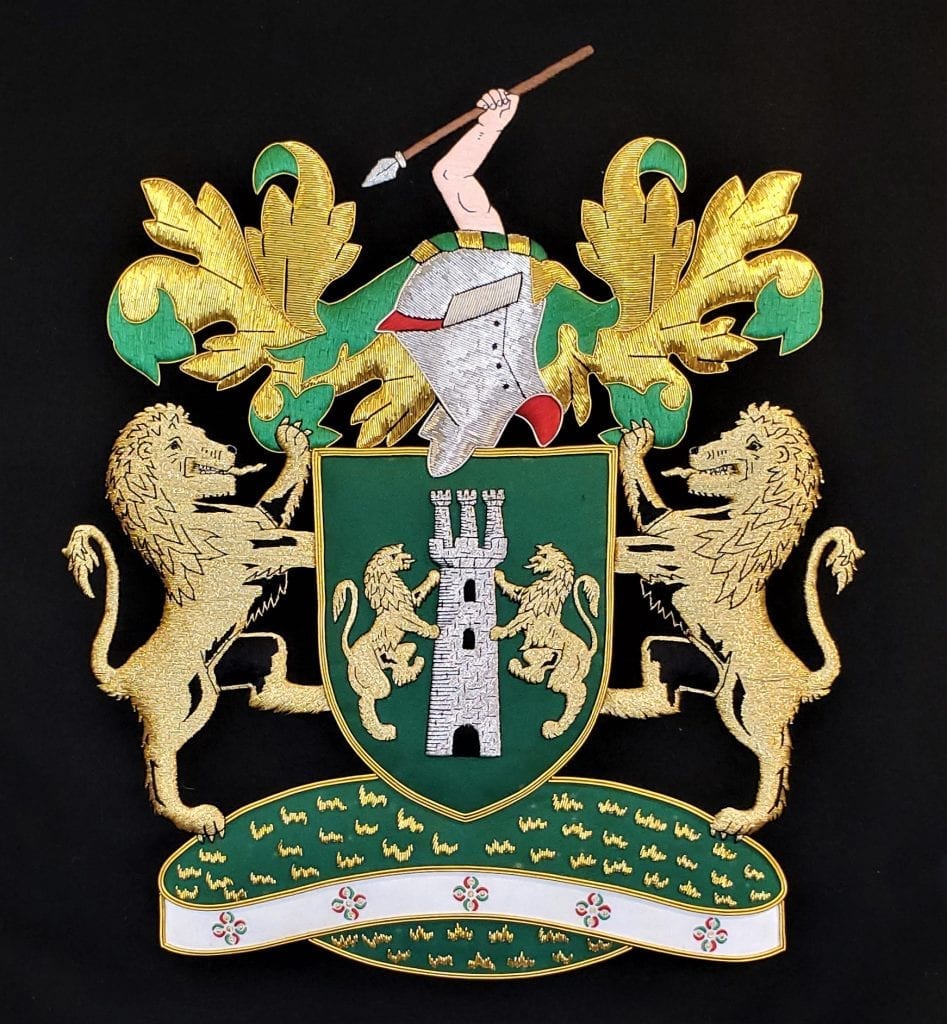
Art Deco Portois and Fix Viennese Tall Case Clock
Provenance: From the Estate of Olga Mangold.
Condition: The case of the piece is in very good original condition. The porcelain dial face has a small crack but the original movement has been completely removed in the 1950’s and was originally replaced with an electric motor mechanism (see photos). This has now been replaced with a fully functional quartz battery operated movement. The pendulum and weights are the originals but purely now serve as decorative only.
Dimensions: 83 inches Tall, 18.75 inches Wide and 11.4 inches Deep
